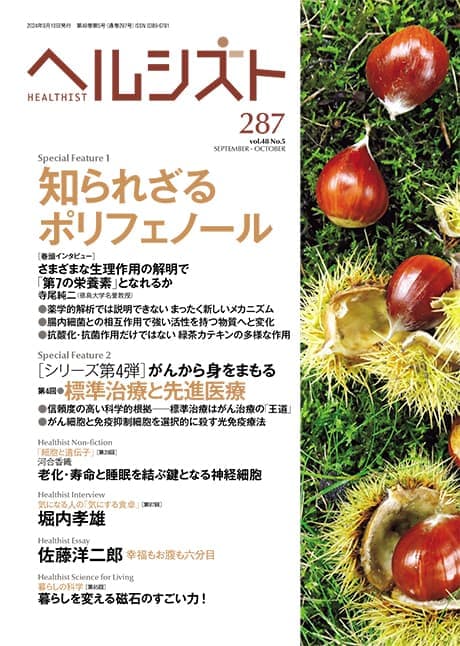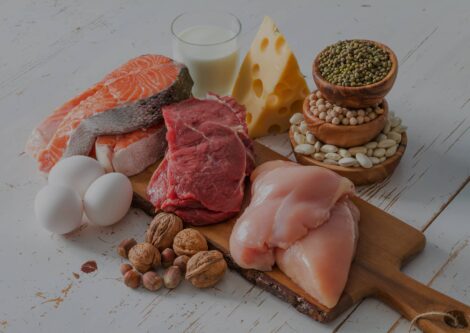Polyphenols have been attracting attention in recent years due to their beneficial effects in such areas as lowering blood pressure and improving glucose tolerance. In fact, however, virtually all the polyphenols we consume are excreted without being absorbed into the body. In other words, unlike micronutrients and pharmaceutical products, the bioavailability of any polyphenols consumed is extremely low. So, why have so many health benefits from their consumption been reported? Scientists say that, activated by polyphenols, the nervous system reduces the risk of chronic disease and sensory function loss. This effect is a completely new mechanism that cannot be explained via pharmaceutical analysis.
Special Feature 1 – The Mysteries of Polyphenols A completely new mechanism that cannot be explained via pharmaceutical analysis
composition by Yuko Watanabe
illustration by Rokuhisa Chino
In Japan, polyphenols have become widely available to the public as functional ingredients in numerous Foods for Specified Health Uses (FOSHU) and Foods with Functional Claims. As they are believed to have various health benefits, including lowering blood pressure and improving glucose tolerance, research into polyphenols is being undertaken both within Japan and overseas.
In 2009, a research team in the EU released the Phenol-Explorer (http://phenol-explorer.eu/) database, which contains information the team compiled on the chemical structure and content values of polyphenols in a range of foods, along with details of their behavior in the body. Epidemiological studies based on this database suggest that polyphenols act to reduce the risk of metabolic syndrome, neurodegenerative diseases in the form of dementia and Parkinson’s disease, and age-related sensory function loss in the form of hearing impairment and cataracts. In addition, many studies have confirmed a rise in peripheral blood flow two hours after consuming at least 200 mg of polyphenols in a single dose.
Almost entirely excreted in feces
The results of the COcoa Supplement and Multivitamin Outcomes Study (COSMOS), a large-scale U.S. trial of the consumption of cocoa-derived flavanol, were published in 2022. In this study of 21,442 elderly Americans (women aged 65 and older, and men aged 60 and older), subjects took 500 mg of cocoa-derived flavanol, including 80 mg of epicatechin, per day for three to four years, and underwent ongoing observation. The results found a marked reduction (-27%) in the cardiovascular disease mortality rate.
Additionally, just under 4,000 of the study participants underwent cognitive function tests. In the stratified analysis in which subjects’ lifestyles were divided into three levels, researchers observed a marked improvement in hippocampal-dependent cognitive function among the group with the lowest health-consciousness (bottom group) as a result of taking cocoa-derived flavanol for a year. As COSMOS provided the first evidence of the efficacy of consuming flavanola type of polyphenol–growing attention has focused on this area.
However, it has become clear that hardly any polyphenols are absorbed by the body, and they are almost entirely excreted in feces. Around 2000, with a research team in my previous job, I carried out a study to measure the blood concentration of polyphenols after their administration, and published an article showing that hardly any polyphenols were detected in the blood (Figure 1). This research topic continues to be explored even now by a variety of teams.
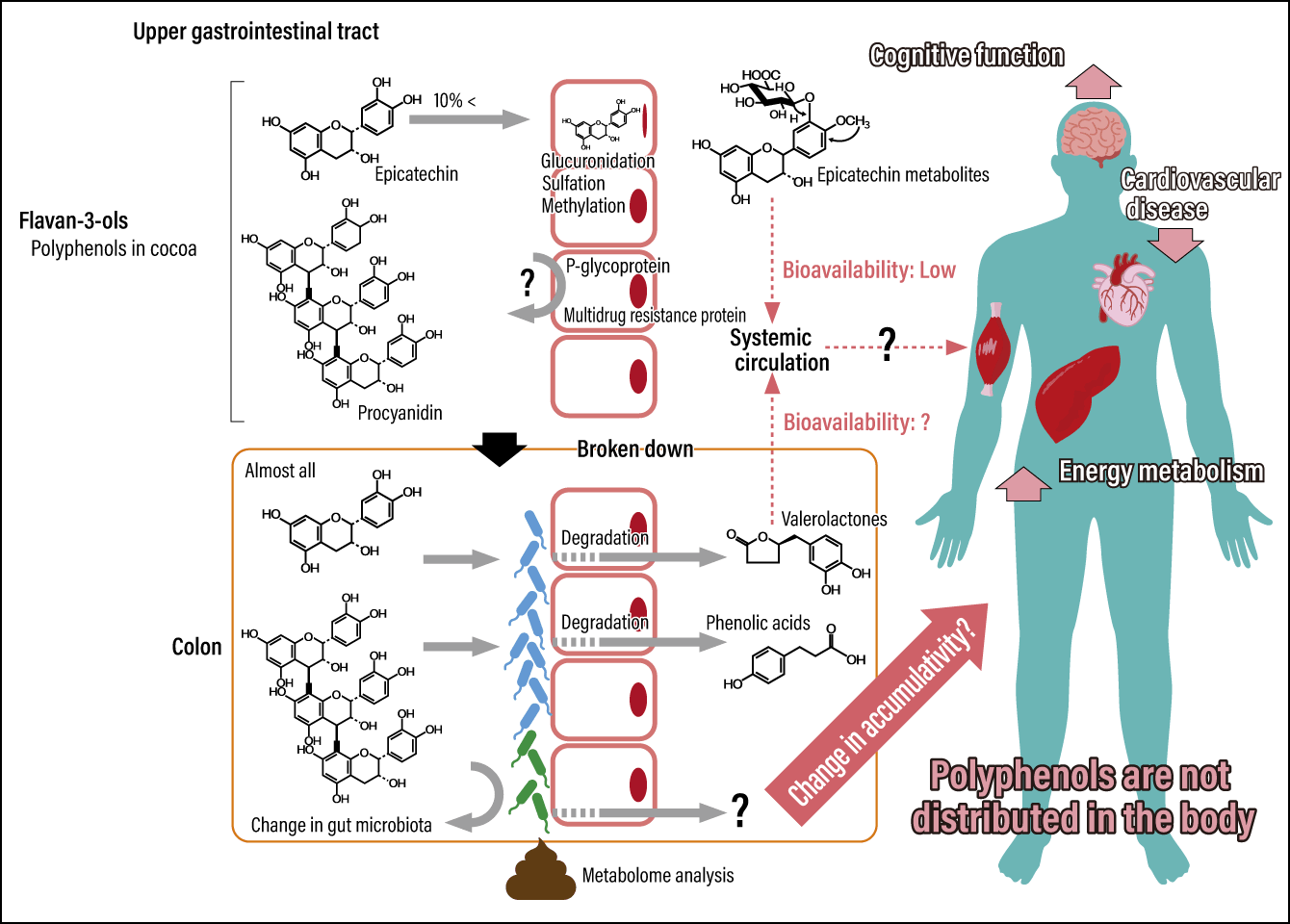 Osakabe N, Terao J.Nutr Rev, 76: 174–184, 2018.
Osakabe N, Terao J.Nutr Rev, 76: 174–184, 2018.
Figure 1. Distribution of polyphenols in the bodyAlthough polyphenols are believed to have such effects as reducing cardiovascular disease mortality rates and increasing energy metabolism, hardly any are distributed in the blood, and they are almost entirely excreted in feces. Based on recent research, it is presumed that the target organ on which they act in the body is the gastrointestinal tract.
In other words, unlike micronutrients and pharmaceutical products, the bioavailability of any polyphenols consumed is thought to be extremely low. Currently, polyphenol research is focusing particular attention on the fact that the gastrointestinal tract, including the mouth, is the target organ of polyphenols.
Our team is building up research aimed at shedding light on the mechanisms behind the effects of polyphenols. As clear changes in the central nervous system and circulatory system have been observed immediately after polyphenol consumption, we thought that the stimulus of consuming polyphenols might have some kind of effect on bioregulation. In particular, we thought that the distinctive bitter and astringent tastes of polyphenols might act on the gastrointestinal tract and exert beneficial physiological effects via the nervous system (Figure 2).
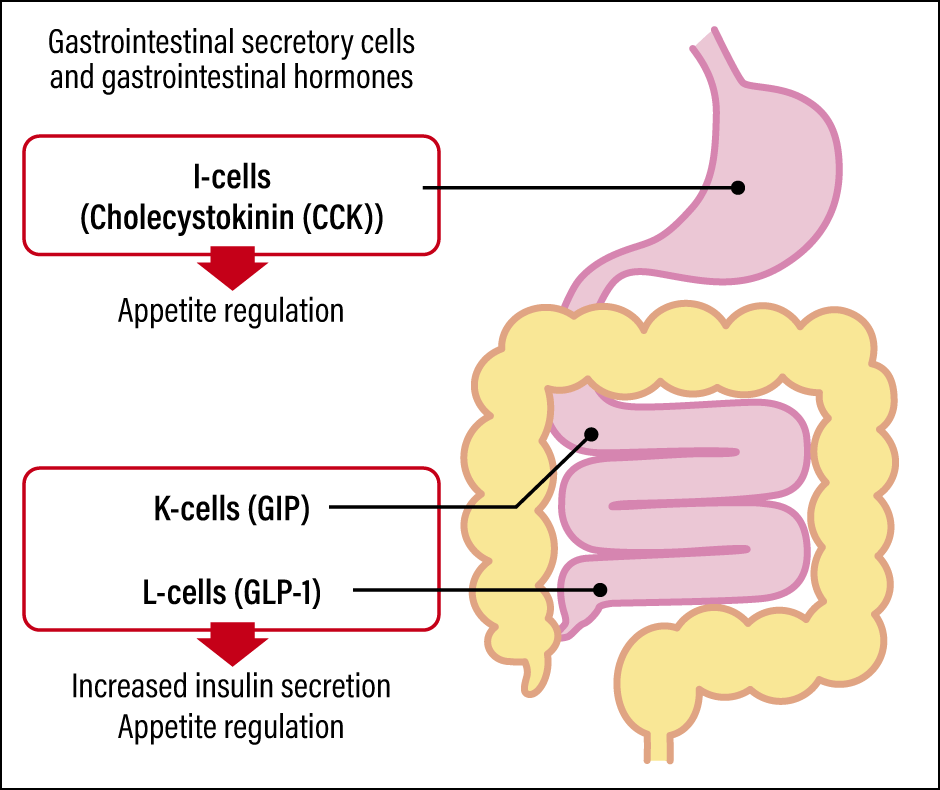
Figure 2. Bitter substances and gastrointestinal hormonesThis study proved that bitter substances in polyphenols stimulate gastrointestinal secretory cells, thereby promoting the production of various gastrointestinal hormones.
Including polyphenols, the number of known bitter substances alone is in the thousands. At the same time, humans are believed to have 25 or 26 different bitter taste receptors, also known as taste receptor type 2 (T2Rs). In the human oral cavity, when T2Rs expressed in the taste buds —— the receptors of taste —— are activated by a bitter substance, nerve action potential occurs and, after passing through the lingual and glossopharyngeal nerves, is transmitted to the gustatory area of the cerebral cortex via the nucleus tractus solitarius of the medulla oblongata and the thalamus, among others.
Recent studies have revealed that T2Rs and other taste receptors are expressed not only in the mouth, but also in the gastrointestinal tract, and perform important functions. T2Rs are expressed in I-cells, which are enteroendocrine cells distributed through the area from the duodenum to the jejunum. Scientists know that T2Rs recognize bitter substances in food, slow down the emptying of stomach contents, and promote the production of cholecystokinin (CCK), thereby delaying a rise in blood glucose levels. In addition, bitter taste stimulation of K-cells, which are distributed throughout the upper small intestine, and L-cells, which are distributed through the ileum and colon, triggers the secretion of the glucose-dependent insulinotropic polypeptide (GIP) incretin and glucagon-like peptide-1 (GLP-1), which are gastrointestinal hormones that promote insulin secretion.
Negative correlation with diabetes risk
In intervention trials using polyphenols, researchers observed rises in blood concentrations of GLP-1 and insulin a few hours after oral ingestion of polyphenols, while glucose tolerance tests showed that rises in blood glucose levels were suppressed. This result is regarded as an indication that bitter taste stimulation by polyphenols is involved in the secretion of various gastrointestinal hormones.
In epidemiological studies, too, a negative correlation between polyphenols and diabetes risk has been observed. As many research reports indicated that consuming polyphenols delayed nutrient digestion and absorption, thereby suppressing rises in blood glucose levels and triglycerides, scientists thought until now that polyphenols’ mechanism of action was to block digestive enzymes. As described above, however, recent studies have noted the possibility that polyphenols suppress gastrointestinal motility and blood glucose levels by activating T2Rs distributed within the gastrointestinal tract, which affects the secretion of gastrointestinal hormones.
Chocolate, red wine, black tea, and berries are all foods perceived as having the astringent tastes characteristic of polyphenols. They are rich in such flavonoids as anthocyanins and catechin oligomers, which is a major factor influencing people’s preferences for such foods.
Intervention trials to date have confirmed that consumption of plant extracts rich in anthocyanins and procyanidins, which are polyphenols perceived as an astringent taste, is followed between 30 minutes and two hours later by a peripheral effect in the form of a marked rise in flow-mediated dilatation (FMD), along with central nervous system effects such as enhanced mood and working memory. FMD has been observed to undergo a marked decline as a result of long-term lifestyle disruption and is used to diagnose early-stage arteriosclerosis.
In order to confirm circulatory system changes immediately after polyphenol administration in laboratory animals, we developed a method of measuring systemic hemodynamics using skeletal muscle microcirculation, blood pressure, and heart rate. Employing oral gavage, we administered to rats more than 30 polyphenol compounds used as active ingredients in FOSHU and Foods with Functional Claims, and then verified changes in hemodynamics with the aid of this method.
At the same time, we conducted sensory analysis of these polyphenol compounds and analyzed the relationship between their effects on the circulatory system and their taste qualities. In the sensory analysis, the compounds were taken into the mouth for tasting before being spat out, as in saké-tasting contests.
The results showed a marked effect in elevating blood flow in skeletal muscle in the “bitter < astringent” polyphenol compound group. We discovered that these effects were hardly expressed at all in the “almost flavorless” and “bitter > astringent” polyphenol compound groups.
Astringent polyphenols, such as anthocyanins and catechin oligomers, demonstrated the effect of elevating blood flow in skeletal muscle arterioles in rats immediately after administration of a low dosage of 10 µg/kg. Tests using adrenergic receptor inhibitors suggested that this effect is based on a sympathetic nervous system stimulation effect.
Incidentally, it was antioxidant effects that were the focus when polyphenols first attracted attention as active ingredients. While antioxidant effects have certainly been observed in in vitro tests conducted under regulated conditions, doubts still remain about whether these effects can also be seen when we consume polyphenols. In short, any antioxidant effects depend on their chemical structure and the test environment. In the plant vacuoles where they occur naturally, polyphenols are stable and slightly acidic, with a hydrogen ion concentration index (pH) of 4-5, but they are known to become unstable when neutral or alkaline. When consumed by humans, polyphenols get quite close to being neutral —— except in the stomach, where gastric acid is secreted —— and therefore become easier to break down.
In order to shed light on differences between the various types of polyphenols, we analyzed their redox ability in a slightly acidic pH range modeled on vacuoles and a neutral pH range modeled on the gastrointestinal tract. As a result, we discovered that catechins and other astringent polyphenols are stable in the slightly acidic range and scavenge superoxide radicals (O2–) —— a type of reactive oxygen species —— but are unstable in neutral pH environments and promote O2– production.
Human homeostasis is regulated by the balance between sympathetic and parasympathetic nerves. Sympathetic nerve excitation is a stress response reaction that occurs for the purpose of appropriately responding to environmental or bodily changes, including temperature changes, exercise, and diet.
Looking at components within foods, consumption of substances such as capsaicin in chili peppers and allyl isothiocyanate in wasabi immediately hyperactivate the sympathetic nerves, prompting a rise in heart rate and blood pressure, along with sweating. Capsaicin and allyl isothiocyanate bind to transient receptor potential (TRP) channels, which express irritation produced on skin and other sensory organs on sensory nerves that run to the central nervous system, and perceive pungent substances, temperature, pH, and reactive oxygen species, among others. This causes the excitation of sympathetic nerves, which convey the stimulus to the brain.
Regulates biological functions by causing sympathetic hyperactivation
We carried out an experiment, thinking that astringent polyphenols might also activate TRP channels. When a single dose of an astringent polyphenol was administered to rats, peripheral blood flow increased. However, there was no change when both an astringent polyphenol and TRP channel inhibitors were administered in combination.
In addition, in silico (research or simulations carried out on a computer) prediction of the affinities of TRP channels and astringent polyphenols revealed that none bind directly to TRP channels.
As described above, we have already confirmed that astringent polyphenols promote O2– production in a neutral pH environment modeled on the gastrointestinal tract. Accordingly, we administered both O2– scavengers and an astringent polyphenol to rats and checked whether there was an increase in blood flow, but were unable to confirm a blood flow elevation effect.
From these findings, it would appear that astringent polyphenols promote O2– production in the gastrointestinal tract and activate TRP channels expressed on sensory nerve endings. We believe that this stimulus might be transmitted to the brain by interneurons, causing sympathetic nerve excitation and increasing peripheral blood flow (Figure 3).
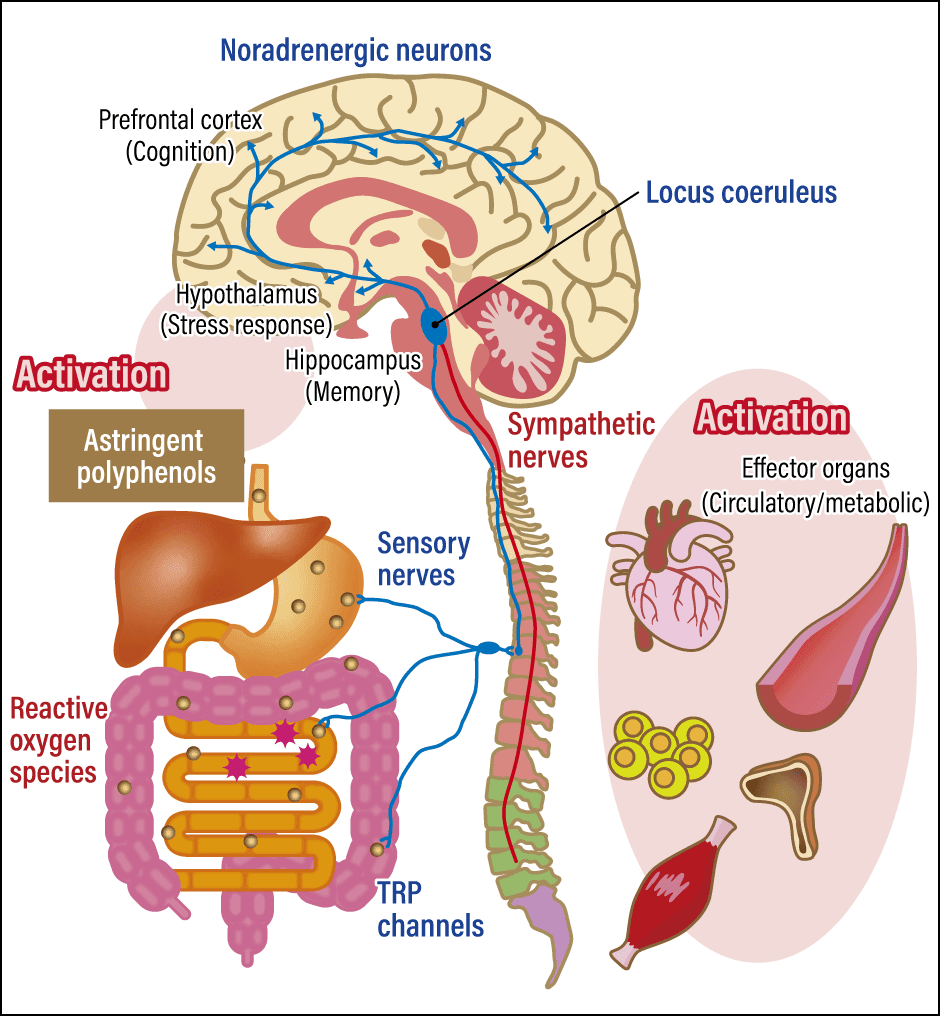 Osakabe N, et al. Front Nutr, 9: 969823, 2022.
Osakabe N, et al. Front Nutr, 9: 969823, 2022.
Figure 3. Mechanism of action of astringent polyphenolsProfessor Osakabe and her colleagues hypothesize that astringent polyphenols are involved in regulating biological functions by promoting the production of O2– in the gastrointestinal tract, creating a stimulus that activates the TRP channels linked to the central nervous system, which then causes the activation of brain function and sympathetic hyperactivation.
In the COSMOS study outlined earlier, long-term consumption of astringent polyphenols was found to improve hippocampal-dependent cognitive function. After repeatedly administering astringent polyphenols, we conducted object location tests to verify the effect on hippocampal-dependent spatial memory, and observed a clear increase in cognitive function. At the same time, we also succeeded in confirming new neuronal proliferation in the dentate gyrus, which is the only part of the brain where neurogenesis occurs, and which is responsible for working memory and behavioral design.
From these findings, we hypothesize that astringent polyphenols’ mechanism of action involves producing O2– in the gastrointestinal tract, including the mouth; this stimulus is then entered into the central nervous system as stress for the human, causing the activation of brain function and sympathetic hyperactivation, which then regulates biological functions.
Pharmaceutical products exert their effects by causing biochemical reactions when their tissue concentration in the target organ increases. The number of times the drug is to be administered in a period (e.g. three times per day) is determined according to the frequency required to maintain a certain blood concentration of the active ingredient; this technology is called a drug delivery system, which controls the effects and side effects of the drug. Pharmaceutical products are only approved after highly rigorous testing of the drug delivery system that provides proof of its mechanism of action.
Pharmaceutical analysis of this kind cannot explain the mechanism of action via which polyphenols benefit the body. We believe that polyphenols have a completely new mechanism, in which their consumption reduces the risk of various chronic diseases and sensory function loss by activating the nervous system via the gut-brain axis. As such, we advocate the inclusion of this biological phenomenon in the field of sensory nutrition. Going forward, we hope to see further progress in research into the effects on the body of not only polyphenols, but also taste, smell, and irritation signals from a variety of food components.







